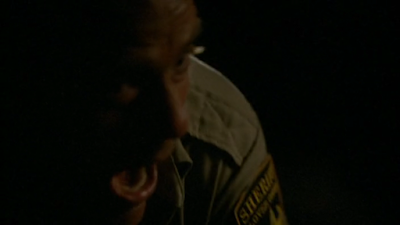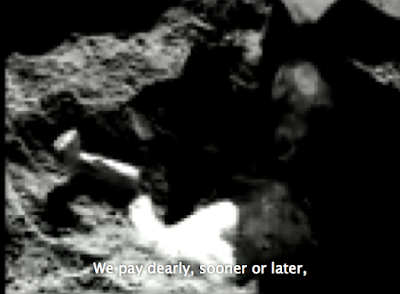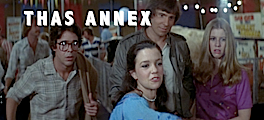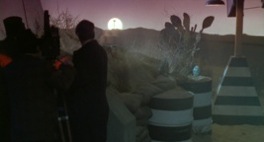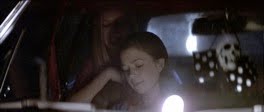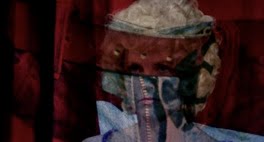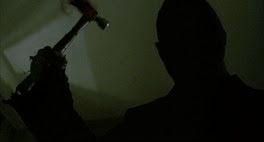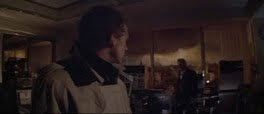"
YI: And on this repeat [of the image of Jennifer Jones and Gregory Peck in Duel of the Sun
] there's an overprint of armed forces and the text is talking about the State, while in the last chapter you quote Bataille to show the opposition between the State and lovers. That's why there's cinema to the power of two in your Histoire(s) du cinéma
, because every time, whether it's with an image from Faust
or one of Cyd Charisse, or indeed with any other quotation, you superimpose or bring together cinematic opposites, the force of the original film you're quoting and at the same time something carried across from the mythic dimension to an artistic one of your own...
JLG: At
the same time what ought perhaps to have been done... one of the
appendices might have taken a text by Mitry or Sadoul, then made a first
power, then a second power, a third, a fourth, and then come back to a
first power that covers all the others. That's what we ought to have
been able to do, but for that there would have had to be several people
thinking together, the way scientists work and their great strength. It
ought to have been possible in cinema... It used to be possible, but
then the notion of the auteur arrived bringing solitude. Becker
didn't feel alone at all, unlike Straub or me. These stories ought to
have been told historically, in any case by cinema historians. At the
time of Jean-Georges Auriol's La Revue du cinéma
they used to
have discussions with each other and that raised the possibility of a
French cinema as distinct from the others. They used to talk to each
other although they felt separate."
Cinema, Jean-Luc Godard & Youssef Ishaghpour
“The painter, the true painter to come, will be he who wrests from the contemporary scene its epic side and shows us, through line and color, how great and poetic we are in our cravats and patent-leather boots.” (Baudelaire, Review of 1845 Salon)

Godard's great experiment for cinema - to have philosophers create it in pass-the-pen melees of thought - is inherently an improbability, he knows this and Ishaghpour knows this, but he still puts the idea forth. The possibility of Utopia still exists, and it exists in the idea of opposition, in mathematical powers of thought, in what "ought to be possible" either in full or partial measure. It also rests in the hands of critics of art, such as Godard, in his Histoire(s) du cinéma, and Charles Baudelaire, in his annual reviews of the Paris Salons, who take it upon themselves to denote the truly modern art, its contextualization in a history of artistic culminations and degradations, and promote the great experiment, compromised it may be: "A form that thinks." (Also of this project, Bataille and his critical study of Edouard Manet, Schiller and his Naïve and Sentimental Poetry, Kant and his Critique of Judgment.)
Baudelaire is thought of as a major figure in the forging of modern art criticism, roving the halls of Salons with a lust for what is new and a hunger for the aesthetic polemic, teasing the strands of the artistic movements of the time that would always boil down to the essentials of Romanticism versus Realism (although he would conclude it is simply the proper adjoining or heuristic of the two that determined true modernism), championing his individualist artists and decrying the de rigueur with the temperament and concept of aesthetic nuance of the modern-day cinephile.

"
JLG: It's because of television and computers. It's the triumph of Edison, because Edison wanted cinema for one person at a time while Lumière... All those philosophers, it's a pity they didn't make cinema..."

(
YI protests against the idea that philosophers should have made films, saying they would be fundamentally incapable.
[--Ed.])
JLG: But he [Deleuze] could have collaborated...
YI: But the result of such a collaboration would have been appalling! There's no shortage of examples...
JLG: People who did collaborate, like Sollers with Fargier and more recently with Labarthe, the result's really nowhere. The text is so dominant, the intention to legislate... but when Sollers writes his literary criticism it's far better, he makes images. I made a whole film out of that: he had written once that if you want to do theatre in Sarajevo you should play Marivaux and not Beckett, that's a film, that's a moment in a film, whether it's written or filmed makes no difference. But Deleuze's books on films are weaker than his philosophical writings."

Stage Beckett (or Sartre) in Dubai.
"
YI: ... For you, though, truth is essentially, indeed I'd say exclusively, of the order of images, both in the material sense of an image and in the metaphorical sense of the third image generated by juxtapositions. Deleuze tried to develop a body of thought on image. With you it's the opposite, more the creation of image thoughts."
"
YI: After Baudelaire there's Proust, with the idea of lost time and recovered time. With Proust in fact the idea of time is very clearly the idea of memory as against photography, which is the trace of death, of disappearance... while memory is recovered time. That's what you do with Histoire(s)
: you feel cinema ought to have been this refuge for time... The Magnificent Ambersons
is not only a film about time. Through these images it associated itself with photographs from the period, and Welles was trying to make a generic product with photographs. It's a film on technique, the one that invented photography and destroys time, but that same technique, cinema, has become a means of salvaging time. The same determination by photography is present in Manet, whose painting can be defined essentially as a reduction to what is seen."

If I saw Djinn previously as a deconstruction of mythic elements (dramatic, psychoanalytical, religious) through an engagement with the contemporaneous, and as a salvaging of cinema's Promethean relationship to nonlinear time (the creation of past and future landscapes, both existing simultaneously), then it is also Godard and Bataille's Manet equivalent: "A reduction to what is seen." Manet's work, or, more precisely, his work along with the criticism of his work, produced a peek into the future, that is, of the art form of cinema (and our ensuing theory of it). Djinn is an extension of a forward-looking cinema, a cinema of a New Impressionism. Godard is the great mind that resurrected this moment of thought, using Bataille's declaration of Manet as the provenance of modern painting as the inspiration for his declaration in Histoire(s) du cinéma of Manet as the provenance of cinema, and the particular way we look at it, how we relate to it, how it relates to our body and existence. This is why art can be contemporary, how art can affect the way we live our existence.
Take Bataille's account of how Manet's Olympia simply transposes the pictorial elements of Titian's Venus into a more contemporaneous setting, removing it of its mythological context and replacing it with total absence and refusal of signification - commenting but simultaneously creating, negating all significance but simultaneously finding meaning in that negation through a fulfillment (of a particular vision, of a "new" way to look and capture images). Djinn performs a similar feat with its divestment of all conventional cinematic modes, its central female figure, Salama, acting as a similarly striking human bounce card for all the "absent" impressionism, by Hooper's own play with light and image. The negation by the digital image... the fulfillment of a materialist reality Djinn fully explores.
"Venus was heavy with languor; Olympia sits up and asserts her
presence, raising her head, shifting her elbow, gazing straight at us
like the pert and very real young woman she is. The setting is virtually
intact: the partition on the left dividing the background in two, the
drape in the upper lefthand corner. The maid-servant, however, has lost
all resemblance with that of Titian’s Venus; she faces us now, standing
beside her mistress’s couch, the milky pink of her dress contrasting
sharply with her features, for she is now a colored woman. The dog,
which in Titian lay curled up at the foot of the bed, has got to its
feet and been changed by Manet into a black cat. Though unimportant in
themselves, these changes are the outward signs of the transition from
one world to another. The world of mythology was nothing without the
dignity which, forthwith, assimilated it to the world
of
theology, of which it was only an elegant variant, devoid of tragic
import, but still imbued with poetic majesty.
Unimportant changes, but
they brought Manet face to face with a problem that had once seemed
insoluble: how is the artist to treat the prosaic aspects of
contemporary man?"
"
YI: When you say that with Manet begins modern painting, that is, cinema, in other words an art making its way towards the word, towards, in fact, forms that think, you add that the flame finally went out at Auschwitz.
JLG: It's a bit sudden, but yes, the possibility of thinking was extinguished at that moment."
James S. Williams lays out this connection between Manet and cinema as conceived by Godard, and the loss of an ideal after Auschwitz, clearly and succinctly in his essay European Culture and Artistic Resistance in Histoire(s) du cinéma Chapter 3A, La Monnaie de l'absolu:
"To paraphrase Godard's voice-over: all Manet's women appear to be saying: 'I know what you're thinking of', no doubt because Manet was the first painter to link the internal world to the cosmos. Even the famous pale smiles of Leonardo da Vinci, Vermeer and Corot (examples of which Godard provides for the reader's scrutiny) proclaim 'me first, the world after'. It is for this reason, according to Godard, that Manet initiated modern painting, that is to say, the cinematograph, or form becoming speech, or more precisely, 'a form that thinks'. In Godard's version of the beginnings of modern art, which names Georges Bataille's study Manet as its point of departure, Manet is promoted as a 'man of cinema' not simply because his career coincided exactly with the beginnings of photography and he looked for truth without falling into naturalism, but because his work facilitates creative thought. This is an intrinsically human moment, one of sudden mutual recognition between the viewer and subject, self and other, self and the world. Godard repeats here a central thesis of Histoire(s) du cinéma: that cinema was initially designed for the purposes of thought but that this was forgotten immediately, the flame being definitively extinguished at Auschwitz."

Police. Propaganda. State
"
YI: You believe there was really thought in cinema before that?
JLG: Even if it wasn't entirely successful, there was the hope... The opportunity wasn't seized.
JLG: There was the idea that it was possible. When Welles made Citizen Kane
, it was because it was still possible.
YI: In a way Welles also belongs to the afterwards. He too had the idea that something had been broken...
JLG: Even Citizen Kane
?
YI: Yes, because cinema and society in the thirties were a sort of unanimism, consensus, American cinema most of all, and Citizen Kane
is an anti-consensus film...
JLG: But it was in the Stroheim tradition, renewed, reinvented...
YI: Also in your film... on top of the image from The Magnificent Ambersons
there's the overprint of a shot of Stroheim directing Greed
, it's the idea of a Stroheim-Welles consanguinity..."
We pick our old guards and vanguards in our dash to reclaim the idea of a cinema that thinks. Welles was and was not. He wanted cinema to live, but it was already petrified, frozen and horrified, Stroheim's novelty replaced by Welles's nostalgia and pessimism.
Nothing is further from the image of the beloved than that of state / Reason of state opposes sovereign value of love / The state has no power, or has lost it, to embrace before us the totality of the world / This totality of the universe / outside, in the loved one as object / inside, in the lover as subject.
Hooper's films have always been about the state of nature, love and biology, in opposition to external forces. Djinn is merely a continuation of this, in which love is already a contract in itself, and the state is a digital simulacrum of what is already a burgeoning global unreality. The totality of the universe merely subsumes love, the totality that is already a vast network of objects and subjects, but from which love's sovereign power is often left out. Hooper reinserts it. Throughout his career, he's pinpointed love as a value and just that. It transmutes more often than it becomes identifiable. Manet also stripped identifiers and made his objects a matter of values versus the state. (It's the propaganda of horror Hooper finds and creates, and inserts the value of humanity within.)
(Continued from Bataille's monograph on Manet [entitled Manet
]:)
“But that’s sheer nonsense,” [Manet] said to [Antonin] Proust. “An artist has got to move with his times and paint what he sees.” Manet did just that; from the very start, at Couture’s studio, he would have none of models who struck heroic poses, but agreed wholeheartedly with Baudelaire—“How great and poetic we are in our cravats and patent leather boots.”
"
JLG: Welles was in the Ford tradition, he had the thoughts for Ford that Ford didn't have for himself... [...] Let's say Welles still thought there were heaps of possibilities... My own view is that you could say broadly that it all stopped between 1940 and 1945, but it's more emblematic to say at Auschwitz...
JLG: It's strange, in literature, with communism and Nazism, a lot of intellectuals wrote books, those books were published and read, and yet everyone carried on just the same... When Malraux and Gide went down to the Association they knew what was going on in Russia... And it's still like that today, when Jospin says he's happy with the outcome of the Pinochet affair, or condemns dictators while rushing off to shake pincers with Kabila or someone... While cinema had certain people of quality, more or less, like Renoir, Ford and Chaplin in particular, and they could have and it wasn't done. "Could do better" as they say, cinema was the favorite son, let's admit it should have been first among the Cassandras and not a peep was heard. So I tell myself: there's something there. And then afterwards, books were published after the concentration camps. They couldn't be less successful, understandably, but at least it had been done at last, while cinema still didn't do it and then when so-called Resistance films were made, and there heaps of them, they were just spy thrillers and so on..."
"So I tell myself: there's something there." I find that statement incredibly poignant, and far be it for me to call a horror ghost movie as any more than the "spy thrillers" that conceived of their relevance but were not, especially in light of Godard's severe judgment on cinema and its inaction in the face of the concentration camps. But the ideal put forth in the beginning of this post, of a cinema that thinks, is both not limited and not possible (in its pure, theoretical state), and so I tell myself, there's something here. Djinn seems essential in the way it communicates large themes through a veil of nothingness, of innovation through lack, action through inaction, inaction through action (facing contemporaneous issues, decades removed from WWII). Another excerpt from Bataille describing Olympia: "Olympia
is meaningful only to the extent that Manet was unwilling to say what
Valéry said ["Cold, naked Olympia, trite monster of love... Bestial vestal dedicated to absolute nakedness..." - Valéry --Ed.], to the extent, on the contrary, that Manet flushed out of
the picture the literal sense Valéry read into it. In her provocative
literalness she is nothing. Her real nudity (not merely that of her
body) is the silence that emanates from her, like that from a sunken
ship. All we have is the “sacred horror” of her presence—presence
whose sheer simplicity is tantamount to absence. Her harsh
realism—which, for the Salon public, was no more than a gorilla-like
ugliness—is inseparable from the concern Manet had to reduce what he
saw to the mute and utter simplicity of what was there. Zola’s realism
located what it described; Manet departed from realism by virtue of the
power he had—at least in Olympia—of not locating his subject anywhere..."
One last Bataille/Manet excerpt:
"Above all else paintings were formerly required to have “finish,” and this it was that consecrated the value inherent in the subject of the picture. Manet, however, found that he could get finer effects in the “sketch” of a picture than in a highly finished work. Such effects thereupon became, as Lionello Venturi puts it, a kind of “finite of the non-finite,” something of far more meaning and consequence than the most minutely wrought canvas. Speaking of Manet, Mallarme declared that it made no difference whether one of his works were entirely finished or not, there being “a harmony amongst all its elements by virtue of which it holds together and possesses a charm easily broken by the addition of a single brushstroke.”
I would stress the fact that what counts in Manet’s canvases is not the subject, but the vibration of light. The role of light in his art is more complex than is implied either by Malraux’s analysis of Manet or by those who see the apotheosis of light in the impressionist technique. To break up the subject and re-establish it on a different basis is not to neglect the subject; so it is in a sacrifice, which takes liberties with the victim and even kills it, but cannot be said to neglect it. After all, the subject in Manet’s pictures is not so much “killed” as simply overshot, outdistanced; not so much obliterated in the interests of pure painting as transfigured by the stark purity of that painting. A whole world of pictorial research is contained in the singularity of his subjects."
 YI: We were talking earlier about using transparencies and tricks of that sort. I think that was a case of reality being canned in advance to be projected on set and incorporated into a fictional world. In that way History, or the real world, was taken metaphorically inside fiction, while you took fiction into the real world... To cite an idea of Benjamin, we've moved from a magical value of cinema to a value of exposure, the historicity that is the effect of technical reproduction."
An apparatus has been erected, she says. / We live in a system in which everything can be done / except the history of what is done. / Everything can be completed except the history of this completion.
YI: We were talking earlier about using transparencies and tricks of that sort. I think that was a case of reality being canned in advance to be projected on set and incorporated into a fictional world. In that way History, or the real world, was taken metaphorically inside fiction, while you took fiction into the real world... To cite an idea of Benjamin, we've moved from a magical value of cinema to a value of exposure, the historicity that is the effect of technical reproduction."
An apparatus has been erected, she says. / We live in a system in which everything can be done / except the history of what is done. / Everything can be completed except the history of this completion.
So Djinn performs a sort of contemporaneous history of what is yet to be completed: the building of buildings, the consuming of man within their own world of materials, the induction of the entire world into this dawn of global modernity.



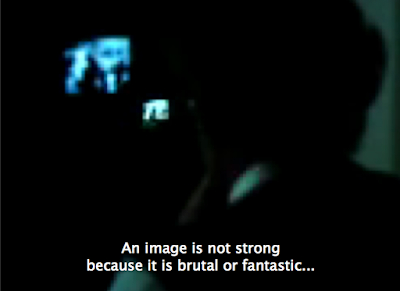



















You see, Péguy, she says, night is always falling. / "An image is not strong because it is brutal or fantastic, but because the association of ideas is distant. Distant and just." / All is eclipsed, and it so happens that the only big problem in cinema / is where and why to start a shot / and where and why to end it. / When we know how many deaths - not symbolic or simulated, / but real ones - one life costs, we no longer care about meaning. / Only a life filled to the bursting point gives meaning to life, irreducible to any meaning. Event that no longer needs to proclaim its assent to itself to become the greatest of assents. Nothing can comprehend this relation of the body to the world. The degree zero of the other is posited when we utter the word "man."
If I may be so bold as to say, Djinn is a film heavy with the idea of consequence and man's actions, of individuality, the human as pawn, or a world as system that punishes resolutely:
THE SIGNS AMONGST US
MAN, THE CAPITAL
Nothing we know remains without atonement.
We pay dearly, sooner or later,
the courage of our thoughts,
the indiscretions of our mind.































